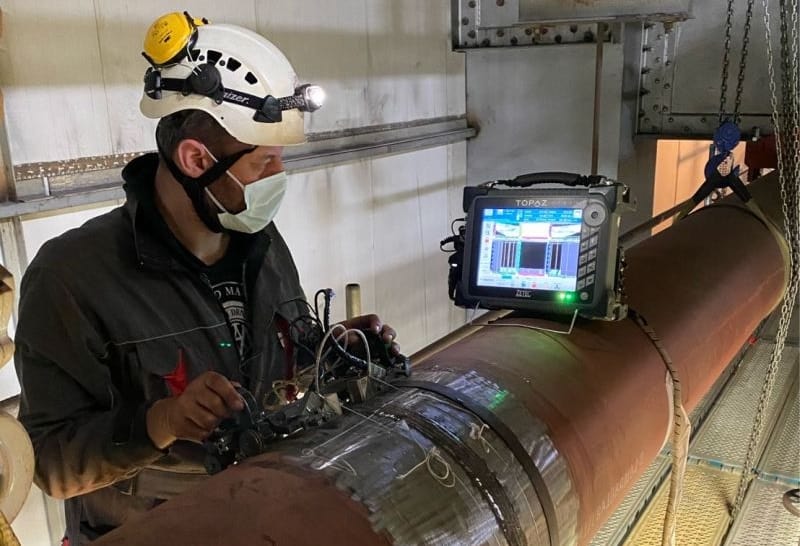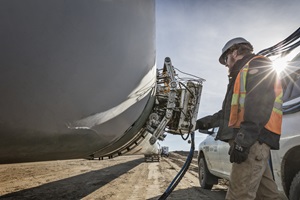Optimizing Effectiveness: Pipeline Welding Inspection Finest Practices
In the world of pipeline construction, the honesty and safety of welded joints are paramount. Guaranteeing that welding evaluations are conducted effectively and efficiently can considerably influence the general high quality of the project. By executing ideal practices for pipeline welding assessment, organizations can streamline procedures, minimize errors, and enhance job timelines. From utilizing advanced modern technology to establishing rigid examination procedures, there are countless methods that can be utilized to maximize performance in this crucial facet of pipe construction - Pipeline Welding Inspection. The precise attention to detail required in welding examination holds the vital to the long-term sturdiness and dependability of the pipelines, making it a subject of utmost importance in the market.

Importance of Effective Welding Examinations
Effective welding evaluations play an important role in guaranteeing the architectural integrity and safety of pipes. Appropriate examinations are necessary to identify any kind of flaws, discontinuities, or blemishes in the bonded joints that could endanger the total honesty of the pipe system. By performing extensive assessments, inspectors can detect concerns early on, avoiding prospective leaks, tears, or failures that could have serious environmental and safety repercussions.
Prompt and accurate welding assessments additionally help in preserving compliance with sector requirements and guidelines. Complying with these criteria is not only a lawful demand but additionally a required step to guarantee the reliability and long life of the pipes. Reliable assessments can add to cost savings by lessening the requirement for expensive repairs or replacements due to welding problems that could have been avoided or fixed during the assessment process.
Using Modern Technology for Inspections
To improve the efficacy and precision of pipe welding assessments, the integration of innovative modern technologies has come to be significantly essential in making certain detailed and exact analyses of welded joints. Using modern technology for evaluations offers countless benefits, consisting of increased effectiveness, improved accuracy, and enhanced precaution. One of the crucial technological improvements in pipe welding assessments is using automated ultrasonic screening (AUT) systems. These systems can check welds quickly and precisely, supplying comprehensive information on potential flaws or concerns within the weld joint. Additionally, remote visual evaluation (RVI) devices such as robot crawlers outfitted with video cameras permit inspectors to accessibility and examine difficult-to-reach areas without the demand for considerable disassembly or hands-on intervention. In addition, the application of electronic systems for information evaluation and reporting streamlines the assessment procedure, making it possible for real-time data interpretation and seamless documentation. By welcoming these technological remedies, pipeline welding evaluations can be carried out better, causing greater top quality welds, enhanced general security, and minimized project timelines.
Developing Clear Assessment Protocols
Establishing clear inspection procedures is important for guaranteeing uniformity and reliability in the pipeline welding assessment process. These procedures work as a collection of guidelines that lay out the specific steps, criteria, and approaches to be adhered to throughout examinations. By plainly defining the inspection methods, all inspectors associated with the process can comprehend their duties and obligations, bring about a much more efficient and standard assessment operations.

Regular evaluation and updates to the examination procedures are also crucial to adjust to altering market standards and demands. By continuously refining and improving the procedures based upon feedback and lessons discovered, pipeline welding evaluations can support the finest quality criteria and governing compliance.
Training and Accreditations for Assessors

Training and qualifications for examiners are critical in making certain the proficiency and effectiveness of people charged with supervising pipe welding procedures - Pipeline Welding Inspection. Correctly trained assessors possess the required understanding and skills to properly evaluate weld high quality, adherence to welding procedures, and compliance with industry standards and regulations
Qualifications, such as those offered by the American Welding Society (AWS) or the American Oil Institute (API), confirm an inspector's experience and capacity to carry out assessments to the highest possible standards. These certifications typically require rigorous training, exams, and continuous expert advancement to guarantee that examiners learn this here now remain current with the most up to date improvements in welding modern technology and assessment strategies.
Along with official qualifications, continuous training programs play a critical duty in improving examiners' capacities. These programs cover a wide variety of topics, including welding procedures, defect detection, safety and security protocols, and appropriate codes and requirements (Pipeline Welding Inspection). By investing in extensive training and qualifications for assessors, companies can promote the integrity of their pipeline welding tasks and mitigate the dangers associated with subpar welds
Continuous Enhancement in Inspection Processes
Structure upon the structure of certified and qualified examiners, constant improvement in assessment procedures is important for making certain the ongoing top quality and compliance of pipe welding procedures. By implementing a system of continuous renovation, pipeline welding inspection procedures can advance to satisfy the altering demands of the market, technological improvements, and regulative demands. This involves regularly examining and assessing assessment devices, treatments, and strategies to identify locations for enhancement.
One trick element of continuous renovation in assessment processes is comments. Collecting input from assessors, welders, designers, and various other stakeholders enables for an extensive evaluation of existing techniques and the identification of prospective locations for improvement. In addition, leveraging information and analytics can offer beneficial understandings into the effectiveness of assessment processes, allowing informed decision-making for optimization.
Moreover, investing in training and advancement programs for examiners can make certain that they are equipped with the most up to date understanding and abilities to perform their tasks effectively. Continual website link renovation is a dynamic procedure that needs devotion and dedication from all stakeholders to drive quality in pipe welding examination techniques.
Conclusion
To conclude, taking full advantage of performance in pipe welding examinations is crucial for ensuring the high quality and safety and security of framework jobs. By using technology, establishing clear protocols, giving proper training and accreditations for assessors, and continuously enhancing evaluation procedures, organizations can improve their procedures and reduce threats. It is crucial for markets to focus on efficient welding examinations to keep high standards and meet regulatory needs.
Reliable examinations can contribute to cost savings by minimizing the demand for expensive repair services sites or replacements due to welding flaws that could have been avoided or remedied during the assessment procedure.
Developing clear inspection protocols is essential for making sure consistency and integrity in the pipe welding assessment process. By plainly defining the assessment protocols, all examiners entailed in the procedure can comprehend their duties and responsibilities, leading to a much more reliable and standardized inspection process.
Clear evaluation protocols assist in minimizing the possibility of mistakes or oversights during the evaluation process.Building upon the foundation of qualified and skilled assessors, continual enhancement in examination procedures is necessary for making certain the continuous top quality and compliance of pipe welding operations.